Amaranth plants typically are annuals or short-lived perennials. The stems often are reddish in colour and sometimes are armed with spines; they bear simple alternately arranged leaves and often feature a pinkish taproot. The plants can be monoecious (flowers of both sexes are on the same individual) or dioecious (each individual produces flowers of a single sex).
The small flowers typically feature colourful bracts and are arranged in dense showy inflorescences; a single plant can produce hundreds or thousands of seeds, borne singly in dry capsule fruits. Amaranthus when grown at home are started from seed each year, although the plants grow vigorously, putting on 2 feet of growth in just one to two months if grown under very warm conditions. Common varieties of Amaranth plants include:
- Amaranthus tricolor
- Amaranthus viridis
- Amaranthus spinosus
- Amaranthus dubius
- Amaranthus hypochondriacus
- Amaranthus caudatus
- Amaranthus cruentus
- Amaranthus hybridus
- Amaranthus retroflexus
- Amaranthus palmeri
- Amaranthus graecizans
- Amaranthus powellii
- Amaranthus blitoides
- Amaranthus albus
- Amaranthus blitum
- Amaranthus muricatus
- Amaranthus deflexus
Amaranthus tricolor

Amaranthus tricolor, known as edible amaranth or commonly called Joseph’s coat, is grown not for its flowers but for its beautifully colored foliage. It is an upright, bushy annual that typically grows to 2-4 feet tall with ovate to elliptic, green to purple leaves.
However a number of cultivars are available in commerce featuring leaves brilliantly blotched with various shades of yellow, red, pink and/or copper, with the upper plant leaves often contrasting in color from the lower ones. Green-leaved species plants are sometimes grown as a vegetable crop (spinach substitute).
Amaranthus viridis

Commonly known as slender amaranth or green amaranth is a vigourous, erect annual or short-lived perennial with a slender branched stem and deeply veined leaves with a long leaf stalk. Occasionally eaten as a cooked vegetable, the leaves are diuretic and purgative and used in poultices to treat inflammations. A decoction of the entire plant is used to stop dysentery and inflammation.
In summer, a dense spike, often with many branches, is packed with small green flowers. They give way to wrinkled fruit capsules that contain smooth and glossy seeds. The nutty edible seeds can be eaten as snacks or used in biscuits.
Amaranthus spinosus
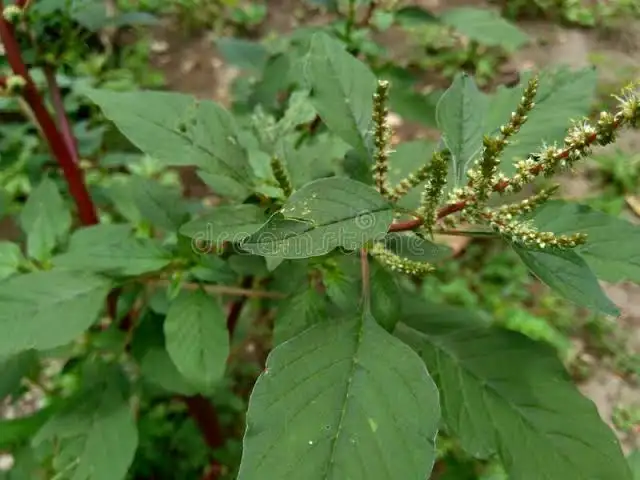
Amaranthus spinosus, commonly known as the spiny amaranth, spiny pigweed, prickly amaranth or thorny amaranth is an erect, often bushy, much-branched summer annual, growing to heights of 2–5 feet. Stems and leaves are smooth and hairless, sometimes shiny in appearance. Each leaf node along the stem bears a pair of rigid, sharp spines. Leaf blades are egg-shaped to diamond-shaped, with the broader end closest to the stem.
Like other pigweeds, spiny amaranth develops a strong taproot with a network of fibrous feeder roots. The taproot may or may not be distinctly reddish in color. Male and female flowers are borne on different regions of the same plant—linear or branched terminal spikes with mostly male flowers, and globular axillary clusters of mostly female flowers.
Amaranthus caudatus
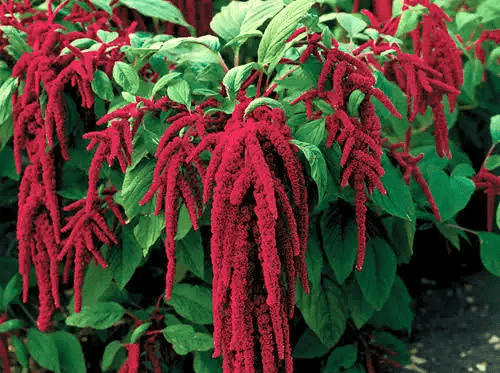
Amaranthus caudatus goes by common names such as love-lies-bleeding, pendant amaranth, tassel flower, velvet flower, foxtail amaranth, and quilete. It is a striking, erect annual or biennial noted for its unusual, long tassel-like racemes of tiny crimson flowers in summer and fall. The blossoms stand out against the foliage of large, light green, ovate leaves.
Wonderfully exotic, Amaranthus caudatus features an upright, bushy habit and adds drama in the garden. Great for the back of the border or as a filler. Its everlasting flowers can be used for fresh or dried arrangements and birds love the seedheads.
Amaranthus cruentus
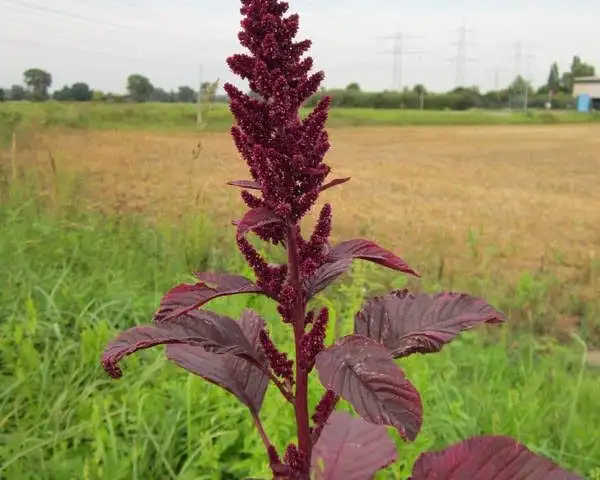
Amaranthus cruentus is believed to have originated from Amaranthus hybridus, with which it shares many morphological features. It’s equally at home among tropical plants or colder climate perennials. The plant is usually green in color, but a purple variant was once grown for use in Inca rituals.
The leaves can be cooked like spinach, and the seeds can be germinated into nutritious sprouts. It has several common names, including blood amaranth, red amaranth, purple amaranth, prince’s feather, and Mexican grain amaranth.
Amaranthus hybridus

Amaranthus hybridus, commonly called smooth amaranth or smooth pigweed is a robust, heavy-branching plant that can reach a height of one metre or more in permissive environments. The leaves are broad, ovate and closely-packed on the main stem and branches making it a typical leafy vegetable.
Amaranthus retroflexus
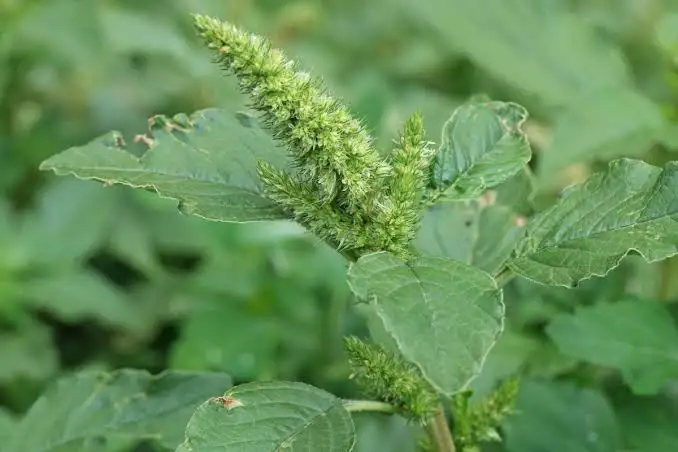
Amaranthus retroflexus goes by several common names, including red-root amaranth or redroot pigweed is an erect, annual herb reaching a maximum height near 9.8 ft. The leaves are nearly 15 cm long on large individuals, the ones higher on the stem having a lance shape and those lower on the plant diamond or oval in shape. The plant is monoecious, with individuals bearing both male and female flowers. The inflorescence is a large, dense cluster of flowers interspersed with spiny green bracts.
Amaranthus hypochondriacus
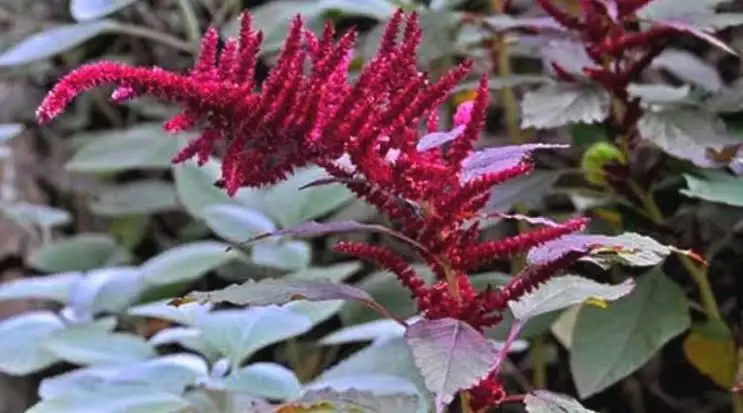
Amaranthus hypochondriacus is an ornamental plant commonly known as Prince-of-Wales feather or prince’s-feather. Originally endemic to Mexico, it is called quelite, bledo and quintonil in Spanish.
Amaranthus hypochondriacus is a vigorous, upright plant that typically reaches 15–80 inches tall. It is often grown for its flowers, which appear in dense, catkin-like inflorescences in the summer and autumn. They are usually deep purplish-red, but may be yellow-green. The leaves are simple and alternately arranged, with entire margins.
Amaranthus palmeri
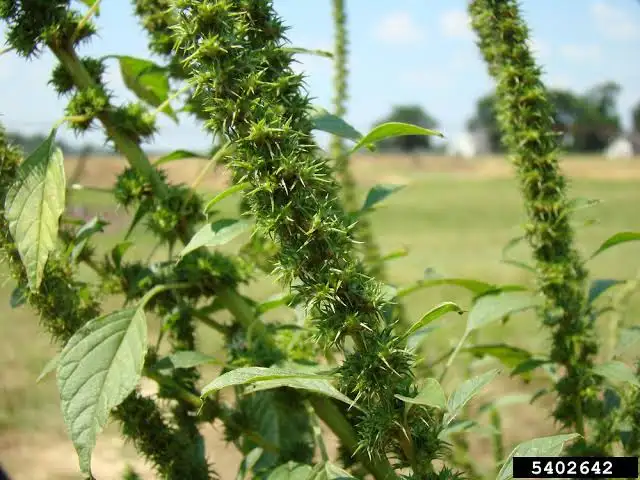
Amaranthus palmeri an extremely aggressive, fast-growing species, with several alternative common names, including carelessweed, dioecious amaranth and Palmer’s amaranth.
Amaranthus palmeri is a tall, erect, branching summer annual, commonly reaching heights of 6–8 feet, and occasionally 10 feet or more. Stems and foliage are mostly smooth and lacking hairs (glabrous).
Leaves have fairly long petioles and are arranged symmetrically around the stem, giving the plant a distinctly pointsettia-like appearance when viewed from above. Leaf blades are elliptical to diamond-shaped with pointed tips.
Amaranthus graecizans

Amaranthus graecizans, the Mediterranean amaranth or short-tepalled pigweed grows up to 50 cm (20 in) tall. Stems are branched from base, glabrous or covered with crisped hairs. The flowers are unisexual and are yellow with round black seeds.
Amaranthus graecizans grows rapidly after rain and can be found in on disturbed ground in the vicinity of human and livestock settlements as well as seasonally flooded sandy flats. The edible leaves are used as a vegetable throughout Africa and the Middle East. It can be eaten raw, but was more often cooked, or added to sauces and stews.
Powell amaranth
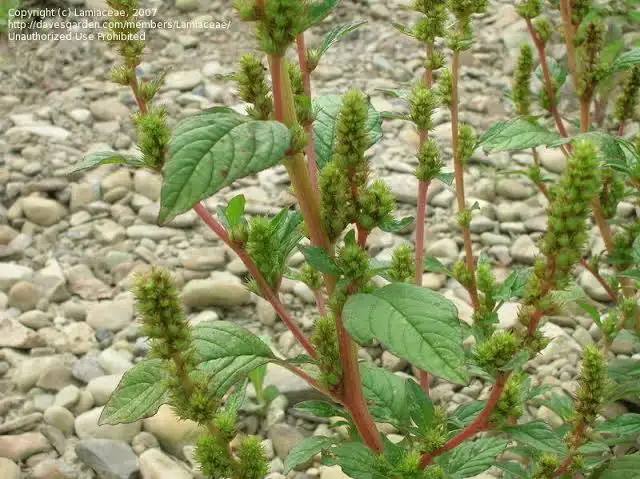
Powell amaranth, also known as green amaranth, is a fast-growing species commonly reaching heights of 3–6 feet. Stems and foliage may be smooth, shiny, and lacking hairs or covered with fine hairs. On mature plants, leaves usually have petioles as long or longer than the leaf blade, and blades distinctly narrowing to a somewhat pointed tip.
Amaranthus blitoides
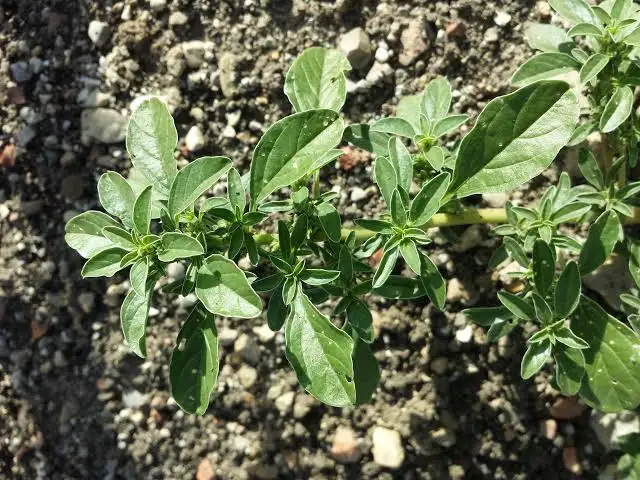
Amaranthus blitoides, commonly called mat amaranth, prostrate pigweed, procumbent pigweed, prostrate amaranth, or matweed, is a glabrous annual plants species. It usually grows up to 0.6 m, though it may grow up to 1 m. It flowers in the summer to fall.
Amaranthus blitoides is a common weed found in a variety of areas from roadsides to agricultural fields. Leaves are usually flat but edges are sometimes slightly wavy and are often whitish. Surfaces are hairless, dull or shiny. The tip is mostly rounded, sometimes indented, and has a small spine-like extension at the apex. Stems are green to red, hairless, usually prostrate, sometimes ascending, and much branched, the branches spreading in all directions.
Amaranthus blitum

Amaranthus blitum, commonly called purple amaranth or Guernsey pigweed is an erect or semi-prostrate annual plant. The single or branched stem can grow to one metre (three point three feet) tall. The green or purplish leaves are up to 10 cm (4 in) long on stalks of a similar length and are arranged spirally. They are simple, roughly triangular in shape and have entire margins. The inflorescence is a spike with the tiny male and female flowers clustered together. The fruits are small globular capsules containing disc-shaped seeds.
Amaranthus muricatus

Amaranthus muricatus, the so-called African amaranth grows to about 60 cm tall. Its glabrous leaves are linear to lanceolate, about 2-5 cm long, with long petioles. Small flowers are produced on compact pyramidal panicles. These flowers, which appear in summer and fall, produce wrinked achenes, about 2 mm long, containing semiglossy, black, lenticular seeds.
Growing Amaranthus
Amaranthus takes very little care apart from regular watering and weed suppression. No nitrogen fertilizer is required for growing, and it can actually impact the quality of the leaves. This type of plant is drought tolerant, but severe soil dryness will stress the plant, inducing flowering and reducing leaf production. Very wet soil is a problem for Amaranthus, so a moderate approach to watering is needed. Provide 1 inch of water each week if no rain falls but water only if the soil feels mostly dry beneath the surface.
Competition from weeds is challenging for young Amaranthus plants, so keeping the bed weed-free is a good idea. One solution that will suppress weeds while also conserving soil moisture around Amaranthus plants is mulch. Spread a 2-inch-thick layer of mulch, such as straw or compost, between the plants once the seedlings have reach a few inches in height, keeping the mulch away from the base of the stems to prevent stem rot.